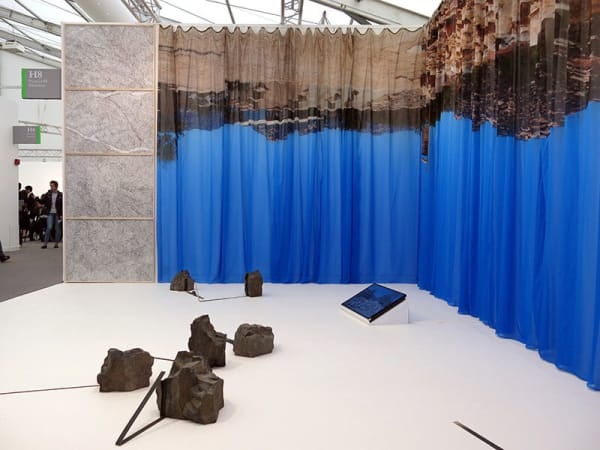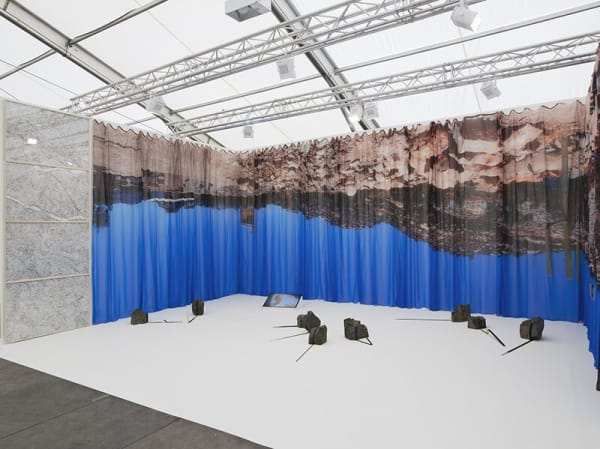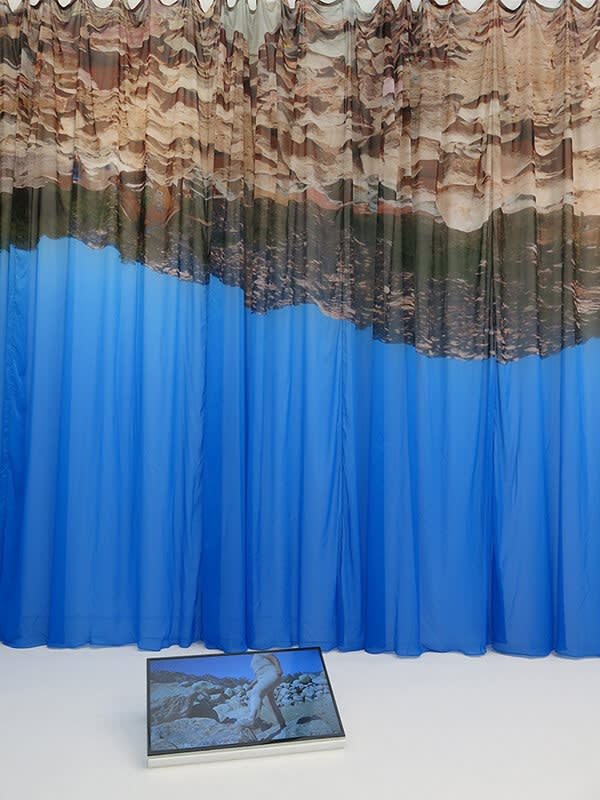Stone Breath Mountain Dust
Blankness is a beginning and an ending, an invitation and a closed door, an empty slab pregnant with possibility and a stony gaze. Organized around the raw blankness of stone, the solo exhibition of Neha Choksi at Frieze London 2016 is a densely interrelated installation featuring freestanding stone sculptures, a video, a sheer curtain, and frottage on paper.
The sculptures come into being through the gouging of a precise vertical notch in basalt rimrocks purposefully sourced from the very edge of cliffs where they are precipitously perched ever exposed to air, ever becoming dust. The rock fragments extracted from the notch are pulverized, transformed into pigment, and applied onto a piece of Belgian linen emerging from the notch—an intentional artifice that is at once an elemental gesture and a sophisticated mark of culture. The negative space of the notch poignantly casts a positive shadow emanating outward as painting. Paradoxically, iconic “nature” is, through the artist’s iconoclastic operations, converted into an object for aesthetic devotion and consumption.
The video shows the artist seemingly conjuring a mountain from dust, absurdly and perhaps futilely kicking first dust, then gravel, pebbles, large rocks, huge boulders, all the way up to an entire mountain. Two stories are relevant to her performance: the artist grew up with her Jain family’s prohibition against kicking stones in order to avoid sowing seeds of aggression in our minds, our relationships, and the world; and Samuel Johnson's famous refutation of George Bishop Berkeley's esse est percipi idealism by kicking an unmovable rock and declaring, I refute it thus.
The sheer curtain pictures a landscape supply company's stone yard where the artist’s performance was filmed. This pairing explores via inversions and reversals the reorganization of natural material by cultural forces. A poetic exploration of the philosophical tug-of-war between idealism and materialism, and the interconnectedness of the geological, cosmological and the human, is encapsulated in two catchphrases: loner poet Emily Dickinson’s the brain is wider than the sky, in one fell swoop encompassing the world in one’s imagination, is countered by environmentalist Aldo Leopold’s thinking like a mountain, a phrase famed for extolling slow interconnectedness from his eponymous note. The diaphanous imagery on the curtain places the sky at one’s feet as well as pictures the inverted mountain at the height of the viewer’s head, site of their intellect and vision. Aptly, Aldo Leopold’s aha moment of realizing the need to “think like a mountain” occurs at the edge of rimrock, the very stone used in the sculptures.
The frottage works continue to intertwine the geological and the human. Made at a granite quarry from which rock has been blasted, honed and distributed to customers, the transfer rubbings mirror that process, themselves trimmed into pieces and framed to be distributed to individuals, dispersed as indexical markings that domesticate and memorialize the in situ loss and subsequent displacement of the quarried rock. The slot in each rimrock sculpture is also a nod to the quarrying of rock.
The act of creation is not unrelated to the act of quarrying stone, of extracting from the materially rich tabula rasa, of drawing grace from inner resources. We must think ecologically with the body.






